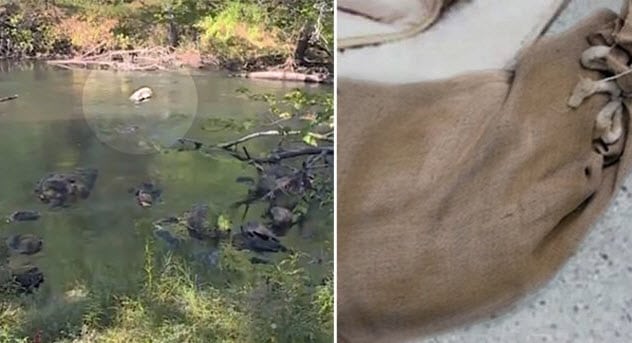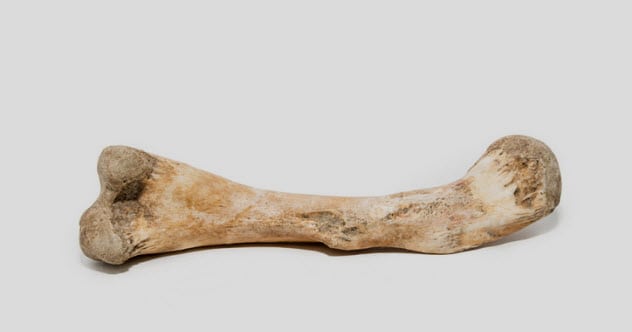 Animals
Animals  Animals
Animals  Gaming
Gaming 10 Game Characters Everyone Hated Playing
 Books
Books 10 Famous Writers Who Were Hypocritical
 Humans
Humans 10 of the World’s Toughest Puzzles Solved in Record Time
 Mysteries
Mysteries 10 Scientific Mysteries We Don’t Fully Understand
 Weird Stuff
Weird Stuff 10 Celebrities Who Have Admitted to Alien Encounters
 Our World
Our World 10 Surprising Secrets of Notre Dame Cathedral
 Miscellaneous
Miscellaneous 10 Intriguing Origins of Popular Carnival Rides
 Weird Stuff
Weird Stuff Ten Unexpected Discoveries Involving Vomit
 Movies and TV
Movies and TV 10 Actors Who Almost Didn’t Take Career-Defining Roles
 Animals
Animals 10 Amazing Animal Tales from the Ancient World
 Gaming
Gaming 10 Game Characters Everyone Hated Playing
 Books
Books 10 Famous Writers Who Were Hypocritical
Who's Behind Listverse?

Jamie Frater
Head Editor
Jamie founded Listverse due to an insatiable desire to share fascinating, obscure, and bizarre facts. He has been a guest speaker on numerous national radio and television stations and is a five time published author.
More About Us Humans
Humans 10 of the World’s Toughest Puzzles Solved in Record Time
 Mysteries
Mysteries 10 Scientific Mysteries We Don’t Fully Understand
 Weird Stuff
Weird Stuff 10 Celebrities Who Have Admitted to Alien Encounters
 Our World
Our World 10 Surprising Secrets of Notre Dame Cathedral
 Miscellaneous
Miscellaneous 10 Intriguing Origins of Popular Carnival Rides
 Weird Stuff
Weird Stuff Ten Unexpected Discoveries Involving Vomit
 Movies and TV
Movies and TV 10 Actors Who Almost Didn’t Take Career-Defining Roles
10 Weird Old Cases Of Bodies Found In Sacks
Sacks containing dead bodies or merely a torso were common finds in the early 20th century. In fact, a quick search through the archives of US and Australian newspapers shows evidence of hundreds of bodies having been found sacked and discarded.
Only a few different types of sacks were used to hold the bodies. But the most common bag was the gunnysack, also called a burlap bag. Cornsacks were also used. But the only difference between the gunnysack and the cornsack was the size of the bag and its original use before a body was placed in it.
There were a few cases of smaller bags being used where the murderer had to chop apart the body and fit it into four different bags, but that was a lot of work for one murder. Few killers were keen on putting in the effort of cleanup.
Most of the body sack cases were never solved. They were simply mentioned in two short sentences in a local newspaper. There were many instances of torsos being found. With nothing else to identify the bodies, the cases remained mysteries for all time.
10 A Floater

The number one rule to getting rid of a sacked body is to weigh it down before dumping it into a deep body of water. There is no telling how many murderers got away with their crimes by following this basic 101 tip. However, some murderers failed miserably at this most basic rule.
For example, James Moore of Texas was a different kind of special. In 1898, he grew jealous of his wife. While she slept one night, he took a hammer and bashed her skull in. After that, he proceeded to stab her with a knife numerous times before stuffing her into a sack.
Moore took his wife’s lifeless body to the Trinity River and threw her in. But he forgot to weigh down the sack, and she was soon found floating in the river. Moore was arrested and confessed to his crime.[1]
9 Four Suspicious Sacks

Early one morning in Indianapolis, Indiana, in 1902, a young man was on his way to work when he spotted two oddly shaped sacks at the back of the Central College of Physicians and Surgeons. As he walked on, he saw an even stranger sight. There was a body-shaped sack sitting on top of a dry goods box.
The young man telephoned the police, and shortly thereafter, the bicycle patrolmen arrived. They opened the sack sitting on the box and discovered a body. A look inside the dry goods box revealed a second body stuffed in a sack. When they went behind the school for doctors, two more bodies were discovered.[2]
An investigation was made, but everyone already knew what was going on. The bodies were recognized as those who had recently been buried in nearby cemeteries and were going to be used by the doctors for dissection.
Seventeen arrests were made, including grave robbers, three doctors, an undertaker, the proprietor of one of the cemeteries, and three watchmen.
8 Half Sacked

In most cases where bodies were stuck inside sacks, the murderer would either fold the body up to make it fit or he would chop off a few of the limbs. However, in 1939, there was a murderer on the loose who just could not be bothered with either of those tasks.
In a private dam in Wycheproof Shire, Victoria, Australia, a body was discovered floating in the water in 1939. What was curious about this particular body was that its legs were in a sack that was tied to the victim’s hips. It was as if the murderer just said to heck with it and tossed the victim into the water half sacked.
There was no mention of any heavy objects in the sack to help weigh it down. Also, the victim had injuries to the head which suggested that the person had been murdered instead of committing suicide.[3]
The identity of the man was not determined.
7 Who Knows And Who Cares?

Out of Montana came a story that was fairly typical of gruesome sack finds. It was 1910, and a chef who was out fishing found a sack containing bones along the bank of a river. The police were called to investigate. When they arrived, they saw the sack with a bone sticking out of it.
The police looked inside the bag and declared the contents to be “too dead to be recognizable.” It could have been a person, a dog, or a calf for all they cared.
Instead of having a professional identify the bones, the men buried the sack where they found it and went on with their day.[4]
6 Laziness Or Lack Of Curiosity

For two weeks back in 1926, thousands of people crossed over the bridge in Wagga Wagga, New South Wales, Australia, and viewed the object floating in the water. No one was all that curious about it because it looked like a bag in the muddy water.
One day, however, a man noticed that the sack was floating higher than before. Upon taking a closer look at the object, he could see an ear and part of a head sticking out from it.
The police were called, and they fished the sack out of the water. Inside it, they found the bloated body of a man.
Although no follow-up on the case could be found in the newspapers, it is rather curious that no one bothered to investigate the bag. After all, this is the type of behavior we expect from modern-day citizens and not from the people of nearly 100 years ago.[5]
5 No Missing Person Report

One of the few ways that the police of the early 20th century were able to name an unidentified body was through the missing persons reports. If someone in the local vicinity had been reported missing, it was either assumed that the body belonged to that person or relatives were brought in for further identification.
If no local person was reported missing and no one confessed to the murder, the discovered body would remain unnamed. Without any form of identification, the case would sit unsolved.
In 1929, a chaff bag washed up on the creek banks in Narrabri, New South Wales, Australia, after some recent floods. A rabbit trapper going about his business found the bag and opened it up.[6]
Inside was the torso of a man. His head, hands, and legs had been hacked off so that the body could fit into the sack and to help prevent identification. It was estimated that the victim had been deceased for a little under three months.
The police inspector was mystified by the case. Not only did he have an unidentified body on his hands, but no one had been reported missing during the three-month time period.
4 Quite A Haul

Fishermen who fail to catch a fish are apt to catch a boot instead. At least that is what we see in the cartoons. Unfortunately, there have been more known instances of bodies being fished out of the water than shoes.
That was the case back in 1910 when a man was fishing at Tooradin, Victoria, Australia. He brought up a heavy sack from the depths of the water and saw a pale, clammy hand sticking out from the side of the sack. The top of the sack had been tied with a rope.
The victim was described as a well-dressed man who had been spotted walking around Tooradin the day before his body was discovered. The locals believed that he was a city man who had been camping by the river.
When the police went to the victim’s campsite, they discovered his clothing neatly arranged and nothing seemed out of place. Naturally, they concluded that the unnamed man had ended his own life in a rather bizarre fashion.[7]
3 Where Is The Rest?

Many of the bodies dumped in lakes and rivers were mere torsos. In the early 1900s, there was no real way to identify these torsos unless they had a tattoo or a unique scar. Often, the torso cases remained unsolved and the rest of the body parts were never discovered.
For instance, in 1914, a sewn-up sack was removed from the Mohawk River in New York. In it was the nude torso of a woman. Her head, arms, and legs were removed. The police investigated the case, but without DNA technology, there was little chance they could identify the unmarked torso.
Again, in 1921, a torso was discovered in Rogers, Texas. This time, the torso was discovered by two fishermen who pulled a floating gunnysack out of the river. Inside the sack, they found a woman’s torso. Her head and legs had been removed, but her arms remained attached.[8]
2 Hair Completely Cut Off

As two men were preparing to leave Lyon, France, one morning and head out to the country, they noticed a strange sack on the ground. Of course, they opened it and discovered the body of a woman. There was blood on her lips and nostrils, and it appeared that someone had cut off all her hair.
The authorities were alerted, and soon enough, the body was identified as that of Marie Servageon. Her husband was located, and he claimed that his wife had disappeared the previous day on June 13, 1908. He found her sudden disappearance rather odd but decided not to contact the police. He said he had hoped that she would return the next morning.[9]
The police were fine with the husband’s seeming lack of concern over his wife’s disappearance. They assumed that she had been kidnapped and murdered by people unknown.
No further reports were made about the case. It appears that the husband was never charged for the murder and that the kidnappers were never discovered.
1 Sacked With Arms Sticking Out

Imagine waking up one morning to head out to the bathroom. You open the door, already expecting the stench on a warm, damp morning. But instead of the smell, you are greeted with a sight that you would not soon forget. In truth, it was something straight out of a horror movie.
It was summer 1910 when a horrifying discovery was made in Bonner, Montana. The body of a man was found inside an outhouse. The victim had been stuffed inside a gunnysack which was then sewn closed. Oddly enough, whoever sewed the victim into the bag had left the man’s arms sticking out of the sides of the bag at the seams.[10]
While suicides in outhouses were fairly common in the early 1900s, it was doubtful that a man might sew himself up inside a bag, leaving his arms out, and then commit the terrible deed. For this reason, the police and investigators at the scene were near certain that this was a case of murder.
Elizabeth lives in the beautiful state of Massachusetts where she is currently involved in researching early American history. She writes and travels in her spare time.
For more weird things that can be done to bodies, check out 10 Creepy Things Killers Have Done To Dead Bodies and 10 Gruesome Ways Bodies Ended Up In Wells.








